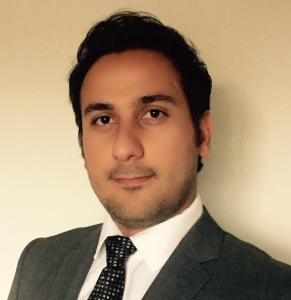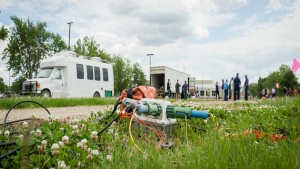K-State Geology faculty member, Dr. Aida Farough, has been invited to participate as a Petrophysics (Physical Properties) Specialist on the International Ocean Discovery Program (IODP) Brothers Arc Flux Expedition (376) that will take place in summer 2018 (Figure A).
Student Story: Focus on Sarah Lamm’s Research
K-State Geology undergrad has “out-of-this-world” internship
What did you do with your summer vacation? Well K-State Geology undergrad, Sarah Lamm, had an experience that was out of this world! She had the opportunity to work as a summer intern at Los Alamos National Laboratory (LANL) alongside planetary scientist, Dr. Nina Lanza, on the ChemCam team. The ChemCam is an instrument on the Curiosity Mars Rover and it can determine rock compositions by using laser pulses to excite rock material into a plasma. As the plasma cools, it releases light at characteristic wavelengths. The goal of her work was to learn more about the manganese oxide minerals the rover found on the martian surface.
Continue reading “Student Story: Focus on Sarah Lamm’s Research”
Promotions and Departures
Meet our New Faculty
 Behzad Ghanbarian is a new Assistant Professor in the Geology Department. His research focus on the Hydrogeology/Petrology interface, applying physically based theories from physics and math, as well as numerical techniques, to model fluid flow and solute transport in heterogeneous porous rocks, fracture networks, soils and sediments. Behzad received his B.S. in water engineering from Isfahan University of Technology in 2005 and an M.Sc. in irrigation and drainage from the University of Tehran in 2007. He received his Ph.D. in environmental sciences from Wright State University in 2014. After that, Behzad joined the Petroleum and Geosystems Engineering Department, University of Texas at Austin, as a postdoctoral research fellow for two and half years. He also worked as a reservoir engineer at the Bureau of Economic Geology, Austin, TX. Behzad received the 2015 Donald L. Turcotte Award, given annually to recent Ph.D. recipients for outstanding dissertation research that contributes directly to the field of nonlinear geophysics. He is author and co-author of more than 50 peer-reviewed articles. Behzad is also co-author of the third edition of the book “Percolation Theory for Flow in Porous Media”, in the Lecture Notes in Physics series published by Springer, and co-editor of the book “Fractals: Concepts and Applications in Geosciences”. He is also serving as a member of the AGU Horton Medal Committee, a highly prestigious award given annually to one honoree in recognition for outstanding contributions to hydrology.
Behzad Ghanbarian is a new Assistant Professor in the Geology Department. His research focus on the Hydrogeology/Petrology interface, applying physically based theories from physics and math, as well as numerical techniques, to model fluid flow and solute transport in heterogeneous porous rocks, fracture networks, soils and sediments. Behzad received his B.S. in water engineering from Isfahan University of Technology in 2005 and an M.Sc. in irrigation and drainage from the University of Tehran in 2007. He received his Ph.D. in environmental sciences from Wright State University in 2014. After that, Behzad joined the Petroleum and Geosystems Engineering Department, University of Texas at Austin, as a postdoctoral research fellow for two and half years. He also worked as a reservoir engineer at the Bureau of Economic Geology, Austin, TX. Behzad received the 2015 Donald L. Turcotte Award, given annually to recent Ph.D. recipients for outstanding dissertation research that contributes directly to the field of nonlinear geophysics. He is author and co-author of more than 50 peer-reviewed articles. Behzad is also co-author of the third edition of the book “Percolation Theory for Flow in Porous Media”, in the Lecture Notes in Physics series published by Springer, and co-editor of the book “Fractals: Concepts and Applications in Geosciences”. He is also serving as a member of the AGU Horton Medal Committee, a highly prestigious award given annually to one honoree in recognition for outstanding contributions to hydrology.
Departure of Dr. Keith Miller
After 27 years at K-State, I have moved back to Pennsylvania and my family for the next phase of my life. I first came to K-State in 1990 as a post doc under Ron West after completing graduate work in paleoecology and event stratigraphy in  the shales of the Middle Devonian Appalachian Basin of upstate New York. That work stimulated my interest in cyclic sedimentation which led to my interest in the mid-continent cyclothems of Kansas. After arriving in Manhattan, I quickly realized that the diverse sedimentary rocks of the early Permian included abundant paleosol profiles. That in turn, led to my collaboration with soil scientist Tom McCahon. Together Tom, Ron, and I published a number of articles on the paleosols and climate cycles of the Kansas Wolfcampian. This culminated in the publication of a monograph on Permian stratigraphy with the KGS.
the shales of the Middle Devonian Appalachian Basin of upstate New York. That work stimulated my interest in cyclic sedimentation which led to my interest in the mid-continent cyclothems of Kansas. After arriving in Manhattan, I quickly realized that the diverse sedimentary rocks of the early Permian included abundant paleosol profiles. That in turn, led to my collaboration with soil scientist Tom McCahon. Together Tom, Ron, and I published a number of articles on the paleosols and climate cycles of the Kansas Wolfcampian. This culminated in the publication of a monograph on Permian stratigraphy with the KGS.
On a parallel track with the paleosol and paleoclimate work, I became increasingly involved with public science literacy, and countering the widespread public skepticism of geologic and climate science. This became a major focus of my time after the 1999 efforts of the Kansas School Board to rewrite the Kansas public school science standards. I was one of the founding board members of Kansas Citizens for Science, a group dedicated to advancing quality public science education in Kansas. Subsequently, much of my writing and speaking was directed toward the public understanding of science and to the science/faith dialog. This remains an important commitment that I intend to continue.
My future directions are rather open at this time. I still have a couple of unfinished publications, and I will be looking for opportunities to be a resource for nearby colleges. I also hope to find local contexts in which I can continue to work for the public understanding of science and to support K-12 educators. My time in Kansas has equipped me with lots of resources and experiences to rely on for my future efforts.
Come and play with our New Sandbox!
One of the “hands-on” modern approaches that facilitates the teaching of difficult 3D concepts, such as the meaning of contour lines and interpretation of topographic maps, is the Augmented Reality (AR) Sandbox. The AR Sandbox uses 3D visualization applications to enable users to create topographic models by shaping real sand, which is then augmented in real time by an elevation color map projected onto the sand; the projection includes topographic contour lines and simulated surface water and precipitation. Students are able to interact with the sandbox and see immediately how different topographies would appear on a map as well as how those differences would affect the movement of water through a landscape or how differences in precipitation might affect that landscape. This equipment will greatly enhance the instructional environment for nearly all introductory geology courses, but particularly GEOL 100 (Earth in Action), GEOL 103 (Introductory Geology Laboratory), GEOL 115 (Environmental Geology) and GEOL 125 (Natural Disasters).

The AR Sandbox was originally developed by W. M. Keck Center for Active Visualization in the Earth Sciences at UC Davis and many organization around the world are now using it. Acquisition of an AR Sandbox along with the EMriver in the department of geology at Kansas State University shows our continuing commitment to providing students with a state-of-the-art learning environment, as envisaged in the University’s 2025 goals.
New Rock Specimens showcase
Welcome to the Department of Geology e-Newsletter
Welcome to the first Department of Geology e-newsletter! We hope this will be the first in a long series of communications intended to keep our alumni, their families, and other friends of the department updated with the latest developments in K-State Geology. We are also hoping that the newsletter becomes more interactive in the future—not only as a way for us to communicate with you but for you to communicate with us.
Focus on Alaskan Research
Dr. Brueseke’s working group is actually conducting an extensive funded research program in the scenic Alaska. Read more about this program on the recent A&S Letters.
Promotions and Departures
We are pleased to announce that two of our faculty members, Dr. Saugata Datta and Dr. Abdelmoneam Raef, were successful this year in their bids for promotion.
A Raman to probe the Earth
The Department of Geology is very pleased to announce the future acquisition of a new state-of-art instrument: A Raman Microscope. This instrument is partially funded by Kansas State University, the Department of Geology and the College of Art & Sciences. The first priority of this facility is to serve students and faculty in a number of geoscience disciplines and courses, e.g. mineralogy, environmental geology, clay mineralogy, geochemistry, economic geology, igneous petrology, petroleum geology, paleoclimatology and Quaternary processes. It will also benefit, and be accessible to, an array of disciplines across campus, including agronomy, engineering, biology, chemistry and geography. Continue reading “A Raman to probe the Earth”
New instrument for subsurface investigation
The Department of Geology is pleased to announce the acquisition of a seismic array. Thank you Paragon Geophysical LLC for this great donation!!!
Continue reading “New instrument for subsurface investigation”

